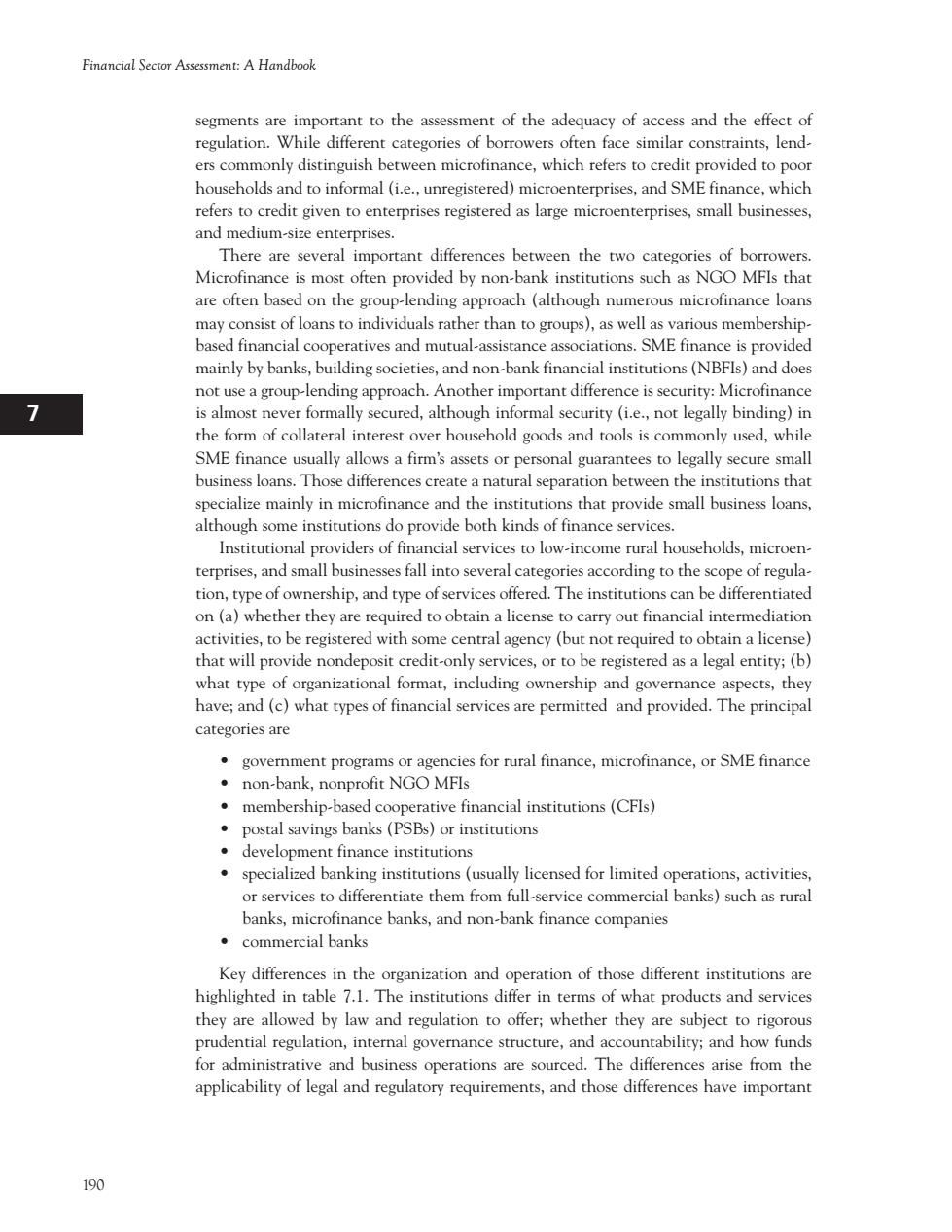正在加载图片...

Financial Sector Assessment:A Handbook segments are sment of the adequacy of access and the effect of regulation.While different categories of borrowers often face similar constrant.lend. ers commonly distinguish between microfinance,which refers to credit provided to poor households and to informal (i.e.,unregistered)microenterprises,and SME finance,which refers to credit given to enterprises registered as large microenterprises,small businesses and medium-size nt mportant differences between the two categorie of bo rower Microfinance is most often provided by non-bank institutions such as NGO MFIs s tha are often based on the group-lending approach (although numerous microfinance loans may consist of loans to individuals rather than to groups),as well as various membership based financial cooperatives and mutual-assistance associations.SME finance is provided mainly by banks,building societies,and non-bank financial institutions(NBFIs)and doe no a group-lendir ng approach.An mportant differen is almost never formally secured,alth secunty enot legally bindi the form of collateral interest over household goods and tools is commonly used,whil SME finance usually allows a firm's assets or personal guarantees to legally secure small business loans.those differences create a natural senaration between the institutions that specialize mainly in microfinance and the institutions that provide small business loans, although some stitutions do ovide both kinds of finan oviders of f cial services to low-income rural households,micro terprises,and small businesses fall into several categories according to the scope of regula tion,type of ownership,and type of services offered.The institutions can be differentiated on(a)whether they are required to obtain a license to carry out financial intermediation activities,to be registered with some central agency (but not required to obtain a license) that will provide nondeposit credit-only services,or to be registered as a legal entity;(b) what typ mat,includin owners spects,they have;and (c)what types of financial services are permitted and provided.The principa categories are .government programs or agencies for rural finance,microfinance,or SME finance .non-bank.nonprofit NGO MFls membership-based cooperative financial institutions(CFIs) ngs banks(PSBs)or institutions ance institution specialized ban ing institutions (usually licensed for limited I operations,activities or services to differentiate them from full-service commercial banks)such as rural banks,microfinance banks,and non-bank finance companies ●.commercial banks key differences in the organization and operation of those different institutions are highlighted in table 7.1.The institutions differ in terms of what products and services they are allowed by law and regulation to offer;whether they are subject to rigorou prudential regulation,internal governance structure,and accountability;and how funds for administrative and business operations are sourced.The differences arise from the applicability of legal and regulatory requirements,and those differences have important 190190 Financial Sector Assessment: A Handbook 1 I H G F E D C B A 12 11 10 9 8 7 6 5 4 3 2 segments are important to the assessment of the adequacy of access and the effect of regulation. While different categories of borrowers often face similar constraints, lenders commonly distinguish between microfinance, which refers to credit provided to poor households and to informal (i.e., unregistered) microenterprises, and SME finance, which refers to credit given to enterprises registered as large microenterprises, small businesses, and medium-size enterprises. There are several important differences between the two categories of borrowers. Microfinance is most often provided by non-bank institutions such as NGO MFIs that are often based on the group-lending approach (although numerous microfinance loans may consist of loans to individuals rather than to groups), as well as various membershipbased financial cooperatives and mutual-assistance associations. SME finance is provided mainly by banks, building societies, and non-bank financial institutions (NBFIs) and does not use a group-lending approach. Another important difference is security: Microfinance is almost never formally secured, although informal security (i.e., not legally binding) in the form of collateral interest over household goods and tools is commonly used, while SME finance usually allows a firm’s assets or personal guarantees to legally secure small business loans. Those differences create a natural separation between the institutions that specialize mainly in microfinance and the institutions that provide small business loans, although some institutions do provide both kinds of finance services. Institutional providers of financial services to low-income rural households, microenterprises, and small businesses fall into several categories according to the scope of regulation, type of ownership, and type of services offered. The institutions can be differentiated on (a) whether they are required to obtain a license to carry out financial intermediation activities, to be registered with some central agency (but not required to obtain a license) that will provide nondeposit credit-only services, or to be registered as a legal entity; (b) what type of organizational format, including ownership and governance aspects, they have; and (c) what types of financial services are permitted and provided. The principal categories are • government programs or agencies for rural finance, microfinance, or SME finance • non-bank, nonprofit NGO MFIs • membership-based cooperative financial institutions (CFIs) • postal savings banks (PSBs) or institutions • development finance institutions • specialized banking institutions (usually licensed for limited operations, activities, or services to differentiate them from full-service commercial banks) such as rural banks, microfinance banks, and non-bank finance companies • commercial banks Key differences in the organization and operation of those different institutions are highlighted in table 7.1. The institutions differ in terms of what products and services they are allowed by law and regulation to offer; whether they are subject to rigorous prudential regulation, internal governance structure, and accountability; and how funds for administrative and business operations are sourced. The differences arise from the applicability of legal and regulatory requirements, and those differences have important